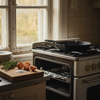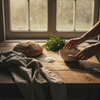How to Whisk Perfectly: Pro Tips & Forever-Chemical-Free Tools
Key Takeaways
- Whisk using a proper side-to-side motion rather than a circular one for best results.
- Choose the right whisk type: balloon whisks for cream and eggs, and French whisks for sauces.
- Opt for forever-chemical-free silicone whisks to protect your cookware and health.
- Maintain consistent technique with brisk, controlled whisking for 2-5 minutes to achieve optimal texture.
Table of Contents
- Whisking 101 – What It Is and Why Technique Matters
- Mastering the Motion – Side-to-Side vs. Circular vs. Beating
- The Right Whisk for Every Task
- Step-by-Step: How to Whisk Like a Pro
- Advanced Whisking – Eggs, Cream, and Sauce Mastery
- Why Forever-Chemical-Free Tools Protect Your Food
- Quick Solutions and Smart Alternatives
- Whisking Matcha – Traditional Technique for Modern Kitchens
- Advanced Problem-Solving for Every Whisking Challenge
- Your Path to Whisking Excellence
How to Whisk Perfectly: Pro Tips & Forever-Chemical-Free Tools
Perfect whisking requires three elements: proper side-to-side motion (not circular), the right tool for your task, and consistent technique. Use balloon whisks for cream and eggs, French whisks for sauces, and always choose forever-chemical-free silicone to protect both your pans and your health. Most recipes reach optimal texture in 2-5 minutes with brisk, controlled whisking.
If you're looking to upgrade your kitchen essentials, award-winning kitchen utensils can make a significant difference in your whisking results and overall cooking experience.
For those who frequently bake or prepare sauces, having a Seamless Series of silicone tools ensures you have the right utensil for every whisking task while protecting your cookware from scratches and chemicals.
Whisking 101 – What It Is and Why Technique Matters
Whisking transforms ingredients through aeration and shear force, incorporating air while breaking down proteins and fats to create new textures. When you how to whisk properly, you're literally restructuring molecules: egg proteins unfold and trap air bubbles, cream fat globules cluster to form peaks, and oil-vinegar emulsions stay perfectly blended.
Real-world scenarios where whisking makes the difference: fluffy pancakes that don't fall flat, scrambled eggs with restaurant-quality creaminess, and vinaigrettes that don't separate on your salad. The key lies in understanding that whisking isn't just mixing, it's controlled chemistry happening in your bowl.
Mastering the Motion – Side-to-Side vs. Circular vs. Beating

| Motion | Best For | How It Works | Typical Results |
|---|---|---|---|
| Side-to-Side | Cream, eggs, batters | Maximizes air incorporation | Fluffy, voluminous texture |
| Circular | Sauces, gravies | Gentle blending motion | Smooth, uniform consistency |
| Beating (up-down) | Stiff egg whites | Rapid air injection | Maximum volume, fast peaks |
Side-to-side motion delivers superior results for most recipes because it creates optimal shear while lifting ingredients through the maximum amount of air. Professional chefs rely on this technique because it provides better control than aggressive beating while achieving faster aeration than circular mixing.
The Right Whisk for Every Task
Not all whisks perform equally, and the material matters more than most home chefs realize. Forever-chemical-free silicone whisks protect your non-stick pans while keeping harmful PFAS compounds away from your food, unlike traditional options that can scratch surfaces or leach chemicals.
For precise measurements in baking and cooking, a 4-piece 18/8 stainless steel measuring cup set is an essential companion to your whisking routine.
Balloon Whisks – Maximum Aeration Power
Best for: Whipped cream, egg whites, light batters
Balloon whisks feature wide, rounded wires that trap maximum air with each stroke. DI ORO's seamless silicone balloon whisks combine this classic design with pro-grade materials, heat-resistant to 600°F and completely free of forever chemicals. The flexible silicone wires bend perfectly around bowl curves without scratching your cookware.
French Whisks – Precision and Control
Best for: Sauces, roux, deep bowls, pan whisking
The narrow profile and straight sides of French whisks excel at reaching into corners and maintaining control in smaller spaces. When you need to how to whisk a delicate sauce directly in the pan, this design prevents scratching while delivering thorough mixing. Perfect for deglazing and creating smooth gravies.
Step-by-Step: How to Whisk Like a Pro
Preparation is everything. Choose a wide, deep bowl, glass or stainless steel provides stability and prevents slipping. For cream, chill your bowl and whisk in the freezer for 15 minutes. Room temperature eggs whisk faster and achieve better volume than cold ones.
Perfect your grip and motion. Hold the whisk comfortably with a loose wrist, most motion comes from wrist rotation, not your entire arm. Use side-to-side strokes, lifting occasionally to maximize air incorporation. Tilt your bowl 20-30 degrees and rotate it slowly with your non-dominant hand to cut whisking time by a third.
For scraping every last bit of batter or cream from your bowl, a 5-piece seamless Di Oro spatula set is the perfect complement to your whisking technique.
Pro Timing Guide: Soft peaks form in 2-3 minutes, stiff peaks in 4-6 minutes with proper technique. For vinaigrettes, 30-60 seconds of steady whisking creates stable emulsion.
Troubleshoot common issues instantly. Eggs not thickening? Check temperature and add a pinch of cream of tartar. Getting splatter? Use a deeper bowl and reduce speed. Cream won't peak? Your bowl or cream may be too warm, chill everything and start over.
Advanced Whisking – Eggs, Cream, and Sauce Mastery

Egg Whites and Yolks – Science Meets Technique
Best for: Meringues, soufflés, fluffy scrambled eggs
Room temperature eggs incorporate air faster as proteins unfold more easily. Use brisk side-to-side motion with periodic lifting to create maximum foam. For stiff peaks, maintain consistent speed for 4-6 minutes, stopping too early results in deflated results, while over-whisking creates grainy texture.
If you want to master more egg techniques, check out how to cook eggs on stainless steel for tips on achieving perfect results every time.
Whipped Cream – Temperature Control Wins
Best for: Dessert toppings, cake filling, coffee enhancement
Chill your bowl and whisk for 15 minutes before starting, cold fat globules cluster faster and hold their shape longer. Add sugar only after soft peaks form to prevent breaking down the cream structure. Watch carefully after 3 minutes; over-whipped cream becomes butter and cannot be rescued.
Vinaigrettes and Sauces – Emulsification Excellence
Best for: Salad dressings, hollandaise, aioli
Start whisking your acid base before adding oil in a thin, steady stream. The classic 3:1 oil-to-vinegar ratio works best, with mustard or honey added for extra stability. Consistent side-to-side motion creates the shear force needed to suspend oil droplets permanently in the mixture.
Why Forever-Chemical-Free Tools Protect Your Food
Traditional metal whisks scratch non-stick surfaces, while plastic versions can leach harmful chemicals into your food. Pro-grade silicone whisks eliminate both problems, they're gentle on cookware while remaining completely free of PFAS, PTFE, and other forever chemicals that persist in your body and environment.
| Material | Health Safety | Pan Protection | Heat Resistance | Durability |
|---|---|---|---|---|
| Silicone (Pro-grade) | Zero forever chemicals | Completely scratch-free | 600°F safe | Lifetime performance |
| Metal | Generally safe | Scratches non-stick | High heat OK | Very durable |
| Plastic | BPA concerns | Can scratch softly | Low heat only | Brittle over time |
DI ORO's award-winning seamless silicone whisks combine the best of all worlds: they're LFGB-certified, dishwasher safe, and backed by America's Test Kitchen recognition. When you how to whisk with quality tools, your non-stick pans last longer and your food stays free from harmful chemical contamination.
To learn more about the science and safety of PFAS and forever chemicals, see this EPA explanation of PFAS.
Quick Solutions and Smart Alternatives
No whisk available? A fork works for small batches using the same side-to-side motion, though it requires more time and effort. For larger batters, two chopsticks held together can substitute in emergencies, while a spoon works for basic mixing but won't achieve proper aeration.
For stirring sauces or scraping the sides of your pan, a 2-piece silicone spoon set is a versatile addition to your kitchen toolkit.
Electric vs. hand whisking: Hand whisking gives you complete control over delicate emulsions like vinaigrettes and prevents over-mixing. Electric mixers excel for high-volume tasks like whipped cream but can quickly destroy delicate textures if you're not careful with timing and speed settings.
Whisking Matcha – Traditional Technique for Modern Kitchens

Traditional matcha preparation requires specific tools and technique that differ completely from standard whisking methods. The bamboo whisk (chasen) and wide tea bowl (chawan) create the signature frothy texture that makes authentic matcha exceptional.
Essential technique breakdown: Sift 1 teaspoon matcha powder into your bowl, add 5 ounces of 160°F water (never boiling), then whisk briskly in "W" or zigzag motions, never circular, for 15-20 seconds until delicate foam forms. The rapid side-to-side motion breaks up clumps while incorporating air for that characteristic frothy top layer.
Common Matcha Mistakes: Using boiling water destroys delicate flavors, circular motions won't create proper foam, and skipping the sifting step leaves bitter clumps that won't dissolve.
Store your bamboo whisk upright to maintain its shape, and rinse with warm water only, soap damages the delicate bamboo fibers. For home chefs who how to whisk matcha regularly, investing in quality traditional tools makes an immediate difference in flavor and presentation.
If you're interested in more foundational cooking techniques, explore how to sauté for step-by-step guidance on building flavor in your dishes.
Advanced Problem-Solving for Every Whisking Challenge
Over-whipped cream rescue: Fold in 1-2 tablespoons of liquid cream very gently, this often saves the texture without starting over. For separated vinaigrettes, start fresh with your acid base and slowly whisk in the broken mixture as if it were oil.
Hot liquid whisking: Use heat-resistant silicone whisks rated to 600°F and reduce your whisking speed to prevent dangerous splattering. When making custards or hot sauces, constant gentle motion prevents curdling better than aggressive whisking.
| Problem | Immediate Solution | Prevention Strategy |
|---|---|---|
| Won't stiffen | Check bowl cleanliness, add cream of tartar | Room temperature eggs, grease-free equipment |
| Excessive splatter | Use deeper bowl, reduce speed | Proper bowl size, controlled motion |
| Scratched cookware | Switch to silicone tools immediately | Forever-chemical-free silicone from start |
For more on the science behind whisking and its culinary applications, see the Wikipedia entry on whisks.
Your Path to Whisking Excellence
Mastering how to whisk transforms ordinary ingredients into extraordinary results, from cloud-like meringues to perfectly emulsified vinaigrettes. The combination of proper technique, quality tools, and understanding your ingredients creates consistent success in every recipe.
Your whisking arsenal essentials: Pro-grade silicone whisks protect your cookware while delivering professional results, proper bowl selection maximizes efficiency, and temperature control determines success with temperature-sensitive ingredients like cream and eggs.
Ready to elevate your whisking game? DI ORO's award-winning, forever-chemical-free silicone tools give you the confidence to tackle any recipe, from your first hollandaise to competition-worthy soufflés. Because when you how to whisk with the right tools and technique, every dish becomes a masterpiece worth sharing.
If you're looking for more ways to perfect your kitchen skills, you might also enjoy reading about how to thicken beef stew for hearty, satisfying results.
Frequently Asked Questions
Why is the side-to-side whisking motion preferred over circular or beating motions for most recipes?
The side-to-side whisking motion maximizes air incorporation, creating a fluffy, voluminous texture ideal for cream, eggs, and batters. Unlike circular motions that gently blend or beating that rapidly injects air, side-to-side whisking offers controlled aeration for consistent, superior results.
What are the differences between balloon whisks and French whisks, and when should each be used?
Balloon whisks have a wide, rounded shape perfect for whipping cream and eggs to incorporate maximum air and volume. French whisks are narrower and stiffer, making them ideal for smoothly blending sauces and gravies without over-aerating.
How do forever-chemical-free silicone whisks benefit both cookware and health compared to traditional whisks?
Forever-chemical-free silicone whisks protect your cookware by preventing scratches and damage while ensuring no harmful chemicals come into contact with your food. This health-first approach means safer cooking and longer-lasting kitchen tools you can trust.
How long should I whisk ingredients like cream or eggs to achieve the best texture, and what technique ensures consistent results?
Whisk cream or eggs briskly and with controlled side-to-side motions for 2 to 5 minutes to reach optimal texture. Maintaining steady speed and consistent technique ensures even aeration and the perfect fluffy or creamy finish every time.




